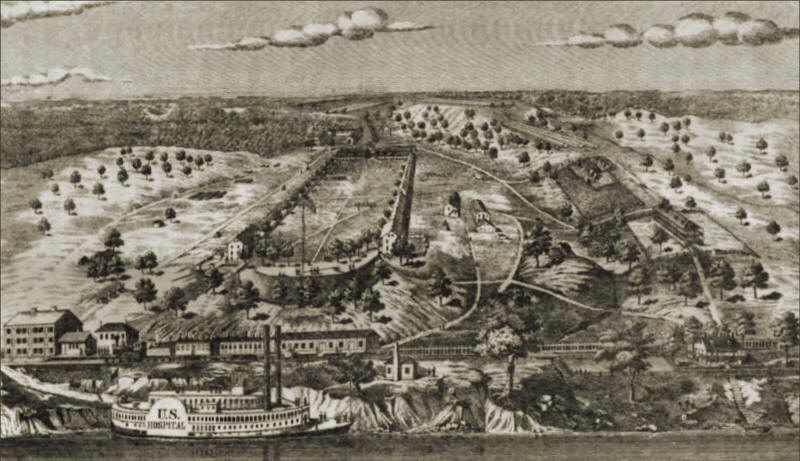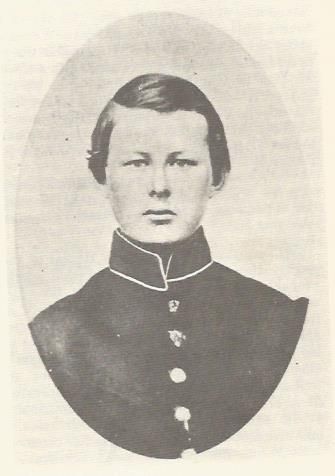Among the Casualties of Shiloh at Jefferson Barracks

As the largest burial ground of Civil War soldiers in the state of Missouri, Jefferson Barracks National Cemetery (just minutes south of St. Louis) is the final resting place of approximately 16,000 Union and Confederate soldiers. Forever under the sod and the dew overlooking the mighty Mississippi River, many of these men died in St. Louis’ hospitals from disease or combat wounds. In the wake of the 158th anniversary of Shiloh, I thought I would share the names and stories of those who fought there and are now buried at Jefferson Barracks.
With a pointed headstone simply marked “10146 F. Alder [sic], Co. F, 2 Tex. Reg., C.S.A.,” rests Pvt. Frederuck Adler. Engaged primarily in the Peach Orchard and against Grant’s Last Line on April 6, Pvt. Adler went “missing from the battle,” according to his Compiled Service Record (CSR). He actually suffered a “gun shot wound” and was captured on the second day. Adler was transported north to the General Hospital in St. Louis for recovery. Sadly, on May 19, he succumbed to his wounds and was interred at Jefferson Barracks, over 800 miles away from where he enlisted – at Galveston, Texas – just one year before.

Pvt. Daniel Burket was 23 years old when he enlisted in Co. C of the 9th Indiana Infantry. The resident of Elkhart County, Indiana was severely wounded at Shiloh on the second day of the fighting. His unit, a part of Hazen’s brigade, advanced on the Confederate positions along the East Corinth Road on April 7 and drove them from the field. Burket was evacuated to St. Louis, where he died of complications on June 1. His brother John was mortally wounded at Fort Fisher in January 1865.
A resident of Allen County, Indiana, 20-year-old Cpl. Jesse Adams was a member of Company D of the 30th Indiana Infantry in Buell’s Army of the Ohio. Arriving at Pittsburg Landing in the early morning of April 7, the 30th Indiana and the rest of Kirk’s Brigade (McCook’s Second Division) fought on the Union right near Water Oaks Pond and Sherman’s Headquarters. At some point during this engagement, Adams was mortally wounded. Like many of the Federal wounded, the Indiana soldier made his way to St. Louis, where he died on April 21, 1862.
Pvt. William Banta (4th Kentucky Infantry) of Bourbon County, Kentucky suffered a “gunshot wound” at Shiloh. According to his Compiled Service Record, he was wounded on the battle’s second day, most likely in the fight near Duncan Field. According to historian and veteran David Reed, “the Fourth Kentucky and Fourth Alabama were engaged in severe conflict north of Duncan Field, where they lost very heavily.” In total, the regiment lost nearly half its men over the two-day conflict. After the Confederate withdrawal, a wounded Banta was left on the battlefield and subsequently captured. Like the others listed here, he made the journey north to St. Louis’ City General Hospital, where he succumbed to his wounds on April 27.

A native of Lincoln County, Tennessee, Pvt. Samuel T. Spence served in Company H, 55th Tennessee Infantry. In Wood’s Third Brigade of Hardee’s Third Corps, the 55th Tennessee was engaged in the early morning attacks against Prentiss’ Division and later against McClernand’s men. Due to confusion after their commander was injured, the 55th Tennessee went to the rear to guard prisoners. At some point during the battle, Spence was shot and mortally wounded. He was later captured by Federals and, due to the severity of his wounds, was placed on the hospital steamer, the Imperial. On the way to St. Louis, he died of his wounds and buried at Jefferson Barracks.
Michigan teenager Pvt. William Davis, who served in the 12th Michigan Infantry in Peabody’s First Brigade, managed to survive the battle of Shiloh. While encamped near Pittsburg Landing after the battle, Davis became stricken with typhoid and was transported north to Jefferson Barracks’ military hospital for treatment. In mid-June, the soldier barely old enough to serve passed away and was buried at the Post Cemetery at Jefferson Barracks, where he rests today.
Stories of sacrifice and suffering like these are abundant throughout Jefferson Barracks National Cemetery. Beneath each one of the cemetery’s thousands of simple headstones rests a soldier and his legacy. It just takes some digging to find them.
Very interesting information; reflects excellent research.
A roster of those unknown to the bright lights of researchers.
But dedicated soldiers nonetheless.
How would I find the records of Confederate Casualties from the Battle of Shiloh, Pittsburgh landing, TN? Before he died, my father requested that I try to find one of his missing relatives from that time who apparently left his Mississippi home to fight with the confederacy and disappeared, never to return. His name was Humphrey Hickman (middle name unknown). Appreciate any direction.
Julia Hickman.